Archives for Phoenix Area Photography category
Click on any image to see an enlarged version.
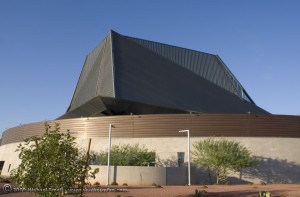
f/22 – 1/20 sec – ISO 100 – Focal Length 18 mm
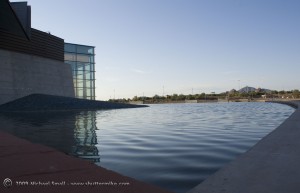
f/8 – 1/250 sec – ISO 100 – Focal Length 18 mm
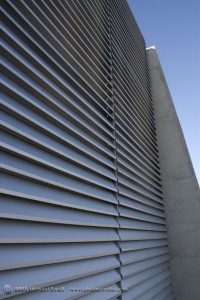
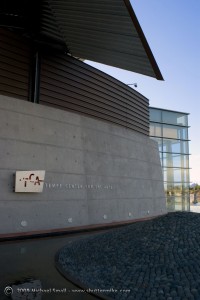
Left – f/6.3 – 1/125 sec – ISO 100 – Focal Length 18 mm
Right – f/8 – 1/100 sec – ISO 100 – Focal Length 24 mm
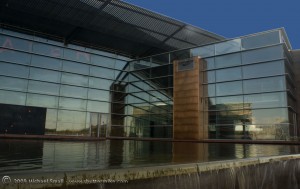
f/16 – 1/10 sec – ISO 100 – Focal Length 18 mm
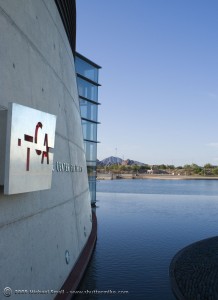
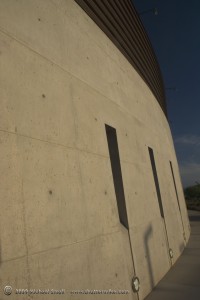
Left – f/7.1 – 1/400 sec – ISO 100 – Focal Length 22 mm
Right – f/20 – 1/30 sec – ISO 100 – Focal Length 18 mm
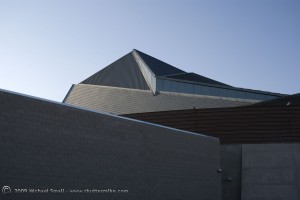
f/4.5 – 1/500 sec – ISO 100 – Focal Length 26 mm
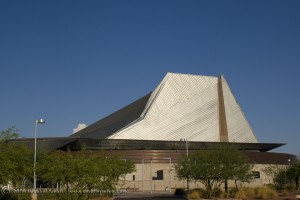
f/11 – 1/320 sec – ISO 100 – Focal Length 30 mm
I went on a photo excursion to the relatively new Tempe Center for the Arts the other day. I had never been before and love the architecture of this building. I did not get a chance to go inside, but if it is half as impressive as the outside I will look forward to getting a chance to see it. I am going to post my general photographs of the building and grounds soon. But in the mean time I played around with focal length in one series of photos just for the sake of comparing what I got by standing in one spot and adjusting the focal settings.
I set the camera on aperture priority and kept the aperture constant at f/13. Since the camera was setting the shutter speed it varied slightly but only between 1/30 and 1/40 second. Then I focused on one spot and shot a series of photographs using 5 of the various focal lengths of m my 18-70mm lens. Here are the results.
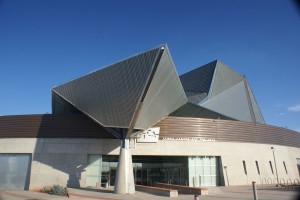
Focal Length = 18 mm
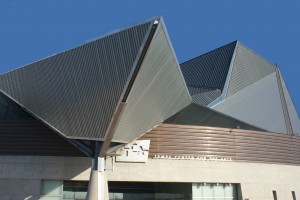
Focal Length = 26 mm
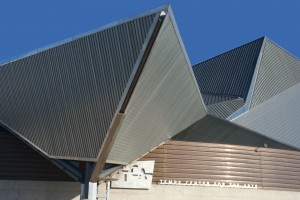
Focal Length = 35 mm
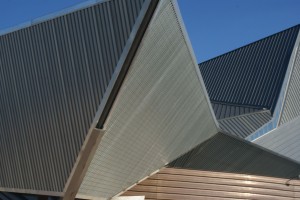
Focal Length = 50 mm
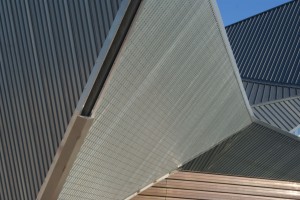
Focal Length = 70 mm
I have photographed Arizona Falls before. I really like the industrial feel that mixes so well with the artistic side of the facility. The lighting at night adds yet another dimension to this hydroelectric power generator in between Phoenix and Scottsdale. (Click on any image below to see a larger version)
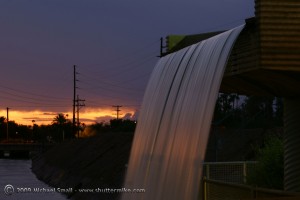
f/9 – 2.5 sec – ISO 100 – Focal Length 70mm
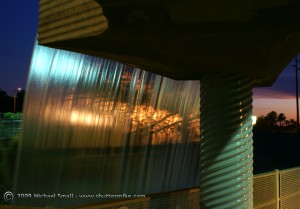
f/6.3 – 4 sec – ISO 100 – Focal Length 28mm
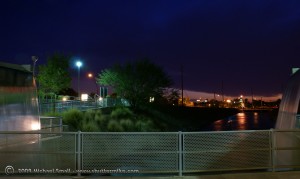
f/5.6- 6 sec – ISO 100 – Focal Length 18mm
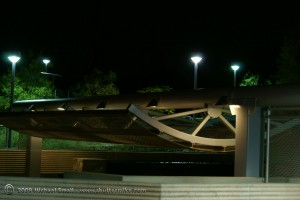
f/7.1- 3.2 sec – ISO 100 – Focal Length 55mm
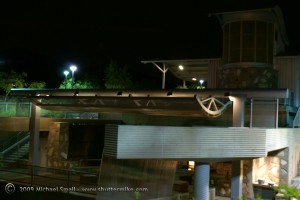
f/5.6- 4 sec – ISO 100 – Focal Length 30mm
Can you stand more night time photography from me? There are two reasons I have been focusing on shooting at night lately. 1) I love it – I love capturing the lights and the moon and just how different the world is at night. I think the general rule for writers applies to photographers as well – write about what you love – photograph what you love. 2) I think it is great practice. I have to try different shutter speeds and apertures (sometimes 6+ per shot) and then go back and study each to determine which produced the best picture. All the time learning more about what works best and how to improve with each shot. As an amateur photographer, attempting to make each shot just a little bit better than the last is what it is all about.
So it was back to the Riparian Preserve in Gilbert. Obviously photographing the wildlife at night was n0t going to work. But the preserve has several structures and the moon was almost full (although my moon picture was not exposed correctly – see below).
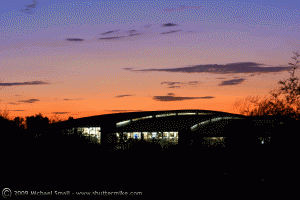
Gilbert Library at the Riparian Preserve
f/10.0 – 1.3 sec – ISO 100 – Focal Length 70 mm
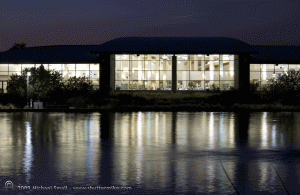
Gilbert Library at the Riparian Preserve
f/9.0 – 2.5 sec – ISO 100 – Focal Length 70 mm
I was not as happy with the following moon shots. The balance of light and dark did not turn out as I would have liked. I took three (four actually, but one was so dark it was not recognizable) and did not get the right shutter speed/aperture combination. I also should have taken it off automatic ISO and experimented with a few different levels to see if I could reduce the noise. But here is what I got with the various settings I used. These were using shutter speed priority so the camera set the aperture. (Note to self – full manual mode next time)
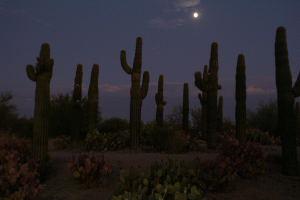
f/4.5 – 1/6 sec – ISO 400 – Focal Length 26 mm
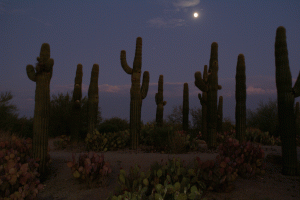
f/4.5 – 1/5 sec – ISO 400 – Focal Length 26 mm
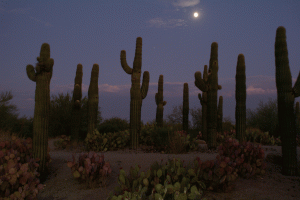
f/4.5 – 1/4 sec – ISO 400 – Focal Length 26 mm
I have been practicing my night photography skills again. This time at Tempe Town Lake in Tempe, AZ. As I get the hang of combining the right shutter speed and f-stop I feel that I am making progress. I came away with several shots from Saturday night’s shoot that I was happy with. Some of the longer shutter speeds (around 8.0 seconds) have some visible noise so I will need to focus on reducing that if possible next time.
A note on Tempe Town Lake: This is a great spot to photograph during the day. But at night the lighting on the shore that reflects into the lake and the bridges is awesome to photograph. There is also a lot of activity in this area which makes for some cool shots.
Click on the images to see a large version.
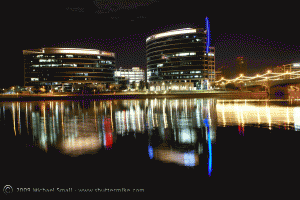
South shore of Tempe Town Lake
Tempe, AZ
5/5.0 – 8.0 sec – ISO 100 – Focal Length 28.0 mm
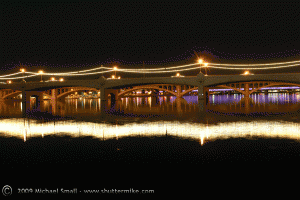
Mill Avenue Bridge over Tempe Town Lake
Tempe, AZ
f/5.0 – 5.0 sec – ISO 100 – Focal Length 28.0 mm
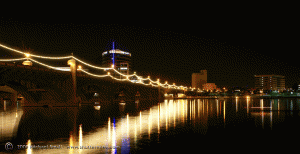
Mill Avenue Bridge over Tempe Town Lake
Tempe, AZ
f/7.1 – 6.0 sec – ISO 100 – Focal Length 28.0 mm
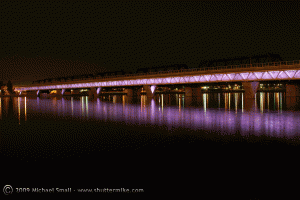
Metro Light Rail Bridge over Tempe Town Lake
Tempe, AZ
f/6.0 – 5.0 sec – ISO 100 – Focal Length 28.0 mm
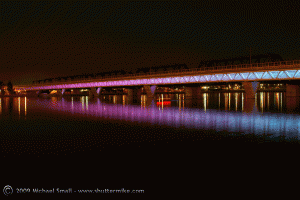
Metro Light Rail Bridge over Tempe Town Lake
Tempe, AZ
f/5.6 – 8.0 sec – ISO 100 – Focal Length 28.0 mm
See August 30’s Photo of the Day post to see the Metro Light Rail Bridge with a train passing over it.
My plan this morning was to photograph the wildlife at the Riparian Preserve in Gilbert, AZ. Although I found a few of the 90 or so photographs that I shot to be acceptable, overall I was not happy with the results of today’s outing. But I did get my photography lesson for the day. That is, not every picture has to be perfect and in fact, the perfect ones are the exception and not the rule. I just have to keep shooting and practicing to get better with every shot.

That is a telephoto lens - not a telescope.
A few other “lessons learned” about wildlife photography in particular as a result of this morning’s outing were:
- Patience is key. When photographing wildlife they do not pose, wait or ham it up for you. You sit and quietly wait for the best shot. You are on their turf.
- Time of day and time of year matters. In the case of the Riparian Preserve, a wetland, there isn’t much water in August. Not much water means not much wildlife, or at least not as many opportunities to photograph them. Make sure you know how the seasons affect the area you are photographing.
- Bug spray, bring it – wetlands, wildlife, outdoors = bugs.
- Size matters and I have lens envy (see the photo at the right).
Click any of the photographs in this post to see a larger version.

Duck at the Riparian Preserve
Gilbert, AZ
f/7.1 – 1/15 sec – ISO 100 – Focal Length 300 mm

Bird Watching – Riparian Preserve – Gilbert, AZ
f/6.3 – 1/400 sec – ISO 320 – Focal Length 250 mm
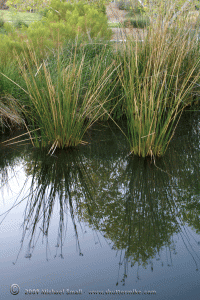
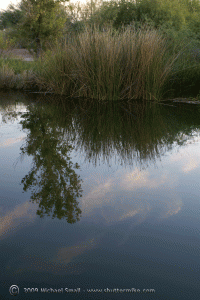
Wetlands – Riparian Preserve – Gilbert, AZ
Right – f/5.6 – 1/20 sec – ISO 400 – Focal Length 35 mm
Left – f/6.3 – 1/20 sec – ISO 200 – Focal Length 40 mm
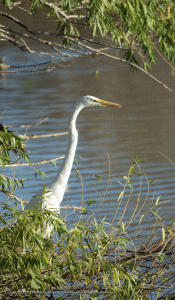
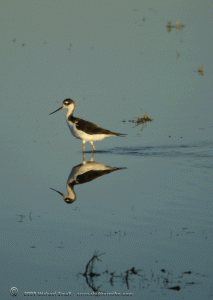
Wetland Birds – Riparian Preserve – Gilbert, AZ
Right – f/6.3 – 1/500 sec – ISO 160 – Focal Length 300 mm
Left – f/6.3 – 1/500 sec – ISO 160 – Focal Length 300 mm
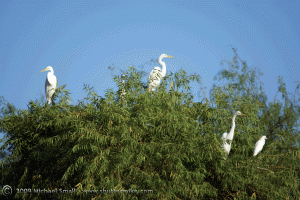
Wetland Birds – Riparian Preserve – Gilbert, AZ
f/6.3 – 1/500 sec – ISO 100 – Focal Length 300 mm

Heron – Riparian Preserve – Gilbert, AZ
f/6.3 – 1/500 sec – ISO 320 – Focal Length 300 mm
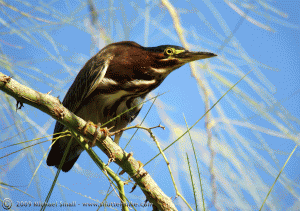
Early morning at the Riparian Preserve
Gilbert, AZ
f/6.3 – 1/400 sec – ISO 320 – Focal length 250 mm
I am not sure which bird on this list this particular guy might be. I’m also not sure if I was watching him or he was watching me. But I caught this shot at the Riparian Preserve in Gilbert, AZ very early this morning. The bird life in this urban refuge is abundant and the photograph opportunities are great. But aside from a camera you need to bring two things if you are going to the Preserve – bug spray and patience. Being wetlands the bugs are out in full force and you need the patience if you want more than some nice snap shots of the wildlife.
9-9-11 – Update: Thanks to Mark Larson, President of the Maricopa Audubon Society, this bird has finally been identified. He is “…an adult Green Heron, a common species in most of North America.” Thank you Mr. Larson. And for future reference there is a guide on the Society’s website to help identify Arizona birds.
The Mesa Arts Center have become one of my favorite places to photograph. There is so much going on architecturally as well as artistically. I had spent some time photographing it during the day not too long ago but had not realized the potential for night photography until I ran across a photograph on Flickr recently. The lighting, textures and colors make for some great shots.
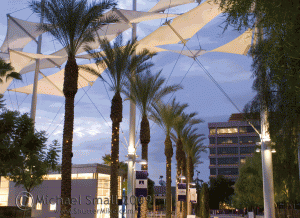
Mesa Arts Center, Mesa, AZ – Looking North
Shutter Speed: .5 sec
f/5.0
ISO 100
Focal Length:28 mm
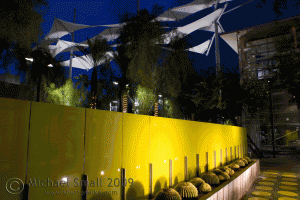
Mesa Arts Center, Mesa, AZ
Shutter Speed: 2 sec
f/8.0
ISO 100
Focal Length:18 mm
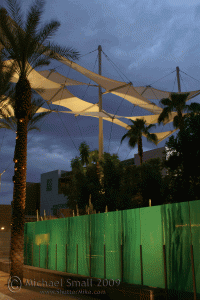
Mesa Arts Center, Mesa, AZ
Shutter Speed: 1 sec
f/5.0
ISO 100
Focal Length:26 mm
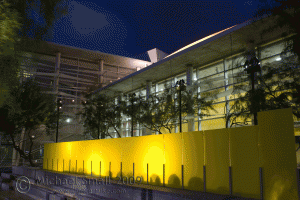
Mesa Arts Center, Mesa, AZ
Shutter Speed: 1 sec
f/4.5
ISO 160
Focal Length:22 mm
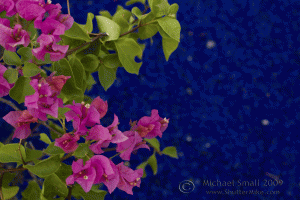
Mesa Arts Center, Mesa, AZ – Bougainvillea
Shutter Speed: 1/25 sec
f/5.6
ISO 160
Focal Length:35 mm
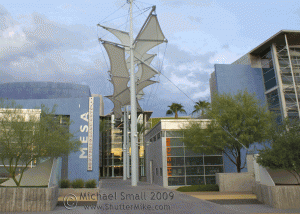
Mesa Arts Center, Mesa, AZ – Looking East
Shutter Speed: 1/25 sec
f/5.0
ISO 160
Focal Length:18 mm
After photographing the fireworks last week I decided to try some more night time photography. South Mountain in Phoenix is known for its sunset and city lights views. A short drive up to the 2600 foot summit gets you to a great lookout over the city perfect for photographing the sky and city below.

This was definitely a trial and error process for me as I am taking the camera off the auto mode and manually adjusting the settings. For this shoot I played with shutter speed to see what I got and hopefully learn something in the process. Ideally I should not be focusing on one setting in the “Exposure Triangle” and leaving the others to default, but I am trying one step at a time.
I got some fair pictures but better yet learned a few things in the process…
- As with shooting fireworks timing is everything. Lesson learned: get to the destination early enough (in this case before the sun starts setting) to stake out a good spot and get everything set up. For photographing city lights twilight is ideal rather than when the sky is completely dark.
- Tripod, tripod, tripod. My camera has image stabilization built into the body. But at slow shutter speed a tripod is critical. A remote would have helped too.
- Underexposure and overexposure are very easy to do. If I had adjusted the aperture and ISO as well as the shutter speed I’m sure I could have improved exposure greatly. Otherwise I need to experiment more to find a happy medium. Or there are some Photoshop tricks to adjust this after the fact. But I prefer to get it right without having to do too much editing.
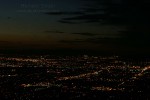
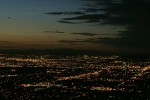
Original Image Corrected in PhotoShop
Click the images to see larger versions.
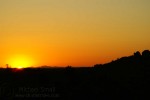

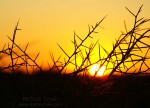
Click on the images to enlarge.
Papago Park is a desert park in Phoenix. It is well know for it’s red sandstone hills. It is also sourrounded by the Desert Botanical Garden to the north and the Phoenix Zoo to the south. With the various hills essentially in the middle of this urban area Paapgo Park is a great place to catch a view of the Arizona sunsets. These shots were taken near Hunt’s Tomb in the east end of the park.























































